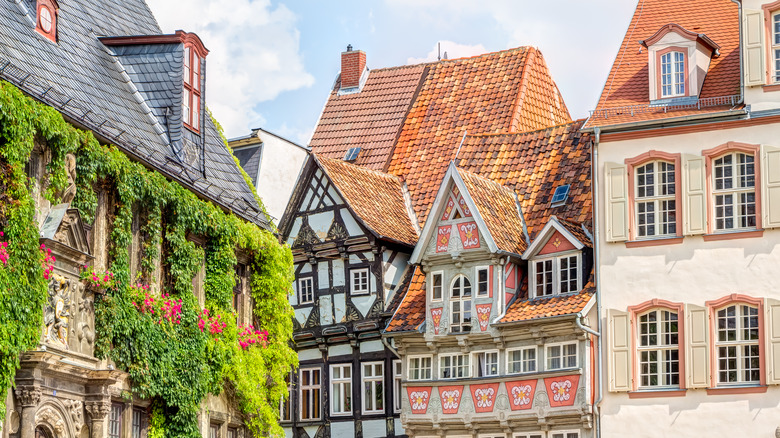Just North Of The Harz Mountains Is Germany's First Capital With Winding Roads & Historic Charm
Just north of the picturesque Harz Mountains in Saxony-Anhalt, Germany, lies the enchanting town of Quedlinburg. Founded in 922, this historic gem holds the distinction of being the first capital of the medieval German Empire. While some say Trier is an overlooked historic beauty boasting several UNESCO sites, Quedlinburg's exceptional preservation and outstanding Romanesque architecture have earned it a coveted spot on the UNESCO World Heritage city list.
During the Middle Ages, Quedlinburg flourished as an influential trading center, leaving an indelible mark on German history. Today, the town boasts more than 2,000 well-preserved houses, each a testament to centuries of architectural evolution. Wandering through Quedlinburg's winding, cobblestone streets feels like stepping back in time, offering visitors a unique glimpse into Germany's rich history.
From its storied past as the birthplace of the German nation to its present-day charm, Quedlinburg stands as a living museum, inviting all its visitors to immerse themselves in its timeless allure. Whether you plan on a flying visit or a longer stay, this little town boasts a wealth of cultural significance and modern touches to keep you busy, making it a must-visit destination for anyone seeking to experience the heart of medieval Germany in the 21st century.
The architectural treasures of Quedlinburg
While Bamberg is often considered one of Europe's most beautiful medieval towns, Quedlinburg's Old Town is a marvel in itself that surely earns the town a similar title, spanning nearly 90 hectares and ranking among the largest in the country. The town's skyline is dominated by half-timbered houses, representing a number of architectural styles. Among these treasures are some of Germany's oldest structures, including the Ständerbau, one of the nation's oldest houses, dating back to 1310.
Perched on a sandstone cliff, the Schlossberg, or Castle, and Stiftskirche St. Servatius stand as sentinels over the town. The church, a prime example of German Romanesque architecture, showcases the grandeur of medieval design with its beams and paned windows. In contrast, the Renaissance-style Rathaus, or City Hall, on the market square represents a later period of architectural evolution, adding to the town's diverse aesthetic tapestry.
Quedlinburg's architectural landscape is further enriched by Jugendstil, or Art Nouveau, buildings from the late 19th and early 20th centuries found on the outskirts of the Old Town. The town's exceptional state of preservation can be attributed to its fortunate escape from major damage during World War II. This remarkable conservation led to the Old Town and Castle being designated a World Culture Heritage by UNESCO in 1994, cementing the town's status as a living monument to German history.
Cultural and modernity
In spite of being an incredibly pretty town, Quedlinburg's historical significance extends beyond its architecture. The town rose to prominence due to Henry I, the Fowler, who is considered the first king of the medieval German state, and the establishment of the Quedlinburg Abbey by his widow, Queen Matilda, in 936. The abbey played a pivotal role in the town's history and development, gaining additional prominence during the reign of Otto I. Additionally, Quedlinburg takes pride in being the birthplace of notable figures in literature and science, such as the poet Friedrich Gottlieb Klopstock and geographer Carl Ritter.
Culture enthusiasts will also find plenty to explore in the town's many museums; the Schlossmuseum, or Castle Museum, offers insights into the town's royal past, while the Fachwerkmuseum, or Half-timbered Museum, celebrates the architectural style that defines Quedlinburg, and the St. Servatius Church houses a treasury of valuable reliquaries and medieval artifacts, providing a glimpse into the town's religious heritage. Throughout the year, Quedlinburg comes alive with cultural events, including an enchanting Christmas market and seasonal festivities that show off some local traditions.
Despite its medieval charm, Quedlinburg seamlessly blends the old with the new. Visitors can enjoy modern amenities like cozy cafes, fine restaurants, and boutique hotels like the Romantik Hotel am Brühl. Local culinary specialties, including the unique Quedlinburg sausage flavored with pine needles, offer a taste of the region's gastronomic heritage. The town's tourism office also caters to various preferences, with mini-train trolley tours and guided walking tours available, as well as convenient access from major cities like Berlin and Frankfurt, so there's no excuse not to visit this historic town, or indeed any other picturesque medieval town steeped in culture and charm just outside of Frankfurt.


